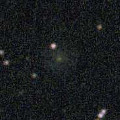
|
Now it is very bright as 11.5 mag (May 24, Michael Jager). It brightens up to 11.5 mag from May to June. However, it locates very low in the Northern Hemisphere. It is not observable in the Southern Hemisphere.
Date(TT) R.A. (2000) Decl. Delta r Elong. m1 Best Time(A, h)
June 8 5 49.20 57 47.1 1.965 1.291 36 11.6 20:57 (152, 14)
June 15 6 37.80 54 43.1 2.010 1.296 33 11.7 21:02 (148, 14)
|
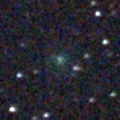
|
Now it is very bright as 11.2 mag (May 31, Chris Wyatt). It brightened very rapidly when it was not observable near by Sun. In the Southern Hemisphere, it stays observable in the evening sky for a long time after this while the comet will be fading. It is not observable at all in the Northern Hemisphere.
Date(TT) R.A. (2000) Decl. Delta r Elong. m1 Best Time(A, h)
June 8 5 53.68 -30 55.1 1.724 1.414 55 11.7 20:57 ( 77,-42)
June 15 6 26.04 -33 30.9 1.691 1.444 58 11.9 21:02 ( 74,-43)
|
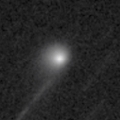
|
Appearing in the morning sky in the Southern Hemisphere. It will appear in the morning sky in late June in the Northern Hemisphere. It will brighten up to 10.5 mag and it will be observable in good condition from autumn to winter.
Date(TT) R.A. (2000) Decl. Delta r Elong. m1 Best Time(A, h)
June 8 2 21.36 3 28.2 4.134 3.468 43 12.5 3:00 (265, -2)
June 15 2 25.63 4 55.2 4.031 3.440 48 12.4 2:58 (266, 4)
|

|
Now it is not observable. It will appear in the morning sky again at 13-14 mag in August.
Date(TT) R.A. (2000) Decl. Delta r Elong. m1 Best Time(A, h)
June 8 4 44.47 19 35.8 3.094 2.086 5 12.8 3:00 (229,-18)
June 15 5 1.37 19 53.6 3.103 2.101 7 12.9 2:58 (230,-16)
|

|
It brightened up to 7.7 mag in June in 2018 (June 19, Juan Jose Gonzalez). Now it is fading. But it is still bright as 13.4 mag (May 30, Chris Wyatt). In the Southern Hemisphere, it stays observable for a long time until the comet will fade out. In the Northern Hemisphere, it is not observable for a long time until autumn when the comet fades out down to 16 mag.
Date(TT) R.A. (2000) Decl. Delta r Elong. m1 Best Time(A, h)
June 8 5 53.19 -31 49.6 4.420 3.943 55 13.4 20:57 ( 77,-42)
June 15 6 0.51 -30 57.8 4.500 3.999 54 13.5 21:02 ( 80,-47)
|
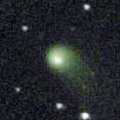
|
Now it is 13.5 mag (May 30, Chris Wyatt). It stays 13-14 mag until summer. It is observable in excellent condition in the Southern Hemisphere. In the Northern Hemisphere, it will be getting lower gradually, and it will be unobservable in July.
Date(TT) R.A. (2000) Decl. Delta r Elong. m1 Best Time(A, h)
June 8 14 51.21 -42 59.4 2.626 3.515 146 13.6 21:44 ( 0, 12)
June 15 14 34.66 -43 9.2 2.714 3.541 138 13.7 21:02 ( 0, 12)
|
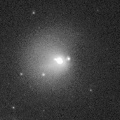
|
Appearing in the morning sky. Now it is bright as 13.7 mag (May 8, Chris Wyatt).
Date(TT) R.A. (2000) Decl. Delta r Elong. m1 Best Time(A, h)
June 8 0 45.74 12 37.5 6.184 5.768 61 13.7 3:00 (270, 23)
June 15 0 49.11 13 8.9 6.087 5.769 67 13.6 2:58 (273, 28)
|
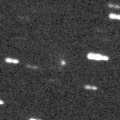
|
Now it is bright as 13.2 mag (May 30, Thomas Lehmann). It stays 13 mag for a long time in 2019. In the Southern Hemisphere, it is observable in excellent condition. In the Northern Hemisphere, it is not observasble until summer in 2020.
Date(TT) R.A. (2000) Decl. Delta r Elong. m1 Best Time(A, h)
June 8 7 30.26 -52 8.9 3.012 3.035 81 13.8 20:57 ( 45,-32)
June 15 7 34.13 -52 16.0 3.032 3.029 80 13.8 21:02 ( 47,-36)
|
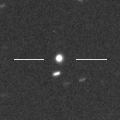
|
It is expected to brighten up to 7 mag in 2020. Now it is not observable. It will appear in the morning sky in July.
Date(TT) R.A. (2000) Decl. Delta r Elong. m1 Best Time(A, h)
June 8 4 5.65 13 18.7 5.206 4.242 16 14.0 3:00 (241,-16)
June 15 4 11.84 14 3.6 5.111 4.177 20 13.9 2:58 (243,-12)
|
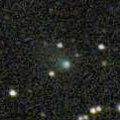
|
It is expected to brighten up to 10 mag in autumn. Now it is 13.4 mag (May 22, Thomas Lehmann). In the Northern Hemisphere, it stays observable for a long time while the comet is brightening. In the Southern Hemisphere, it it not observable until mid September.
Date(TT) R.A. (2000) Decl. Delta r Elong. m1 Best Time(A, h)
June 8 4 13.07 63 26.9 2.554 1.916 41 14.4 3:00 (203, 18)
June 15 4 18.19 62 35.2 2.496 1.856 41 14.2 2:58 (206, 20)
|

|
It approached to Earth down to 0.3 a.u. in mid February, and brightened up to 5.5 mag (Feb. 13, Juan Jose Gonzalez). Now it is fading. It has already faded down to 13.0 mag (Apr. 24, M. Lehky). Now it is not observable. It will appear in the morning sky in July in the Northern Hemisphere, or in August in the Southern Hemisphere.
Date(TT) R.A. (2000) Decl. Delta r Elong. m1 Best Time(A, h)
June 8 4 38.89 35 15.2 3.123 2.149 13 14.5 3:00 (220, -5)
June 15 4 40.98 35 38.8 3.178 2.223 16 14.7 2:58 (223, -2)
|

|
Now it is 14.4 mag (May 8, Chris Wyatt). In the Southern Hemisphere, it is observable for a long time. In the Northern Hemisphere, it will never be observable again.
Date(TT) R.A. (2000) Decl. Delta r Elong. m1 Best Time(A, h)
June 8 0 24.42 -45 0.9 3.896 4.069 92 14.7 3:00 (319, -9)
June 15 0 27.32 -44 55.9 3.836 4.086 96 14.7 2:58 (322, -6)
|
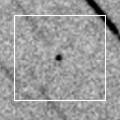
|
It passes the perihelion on July 2. Then it brightens up to 13 mag, but it is not observable around that time. In the Northern Hemisphere, it will appear in the morning sky at 16 mag in late July. In the Southern Hemisphere, it will be too low to observe.
Date(TT) R.A. (2000) Decl. Delta r Elong. m1 Best Time(A, h)
June 8 5 27.64 22 18.7 1.749 0.746 5 15.4 20:57 (131,-15)
June 15 5 54.42 21 31.6 1.596 0.594 5 14.8 21:02 (132,-16)
|
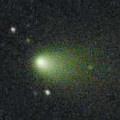
|
It brightened up to 12-13 mag from winter to spring. Now it is fading. It has already faded down to 14.5 mag (May 23, Katsumi Yoshimoto). It is observable in excellent condition in the Northern Hemisphere. It locates somewhat low in the Southern Hemisphere.
Date(TT) R.A. (2000) Decl. Delta r Elong. m1 Best Time(A, h)
June 8 11 32.63 13 6.9 2.067 2.331 91 14.9 20:57 ( 66, 50)
June 15 11 40.27 11 19.7 2.165 2.353 87 15.1 21:02 ( 70, 44)
|
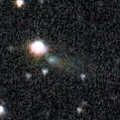
|
Now it is 14.4 mag (May 27, Catalina Sky Survey). It brightens up to 15 mag from May to June, and it will be observable in good condition.
Date(TT) R.A. (2000) Decl. Delta r Elong. m1 Best Time(A, h)
June 8 23 18.29 34 28.2 1.569 1.620 74 15.1 3:00 (256, 50)
June 15 23 35.45 36 53.4 1.573 1.644 75 15.1 2:58 (253, 53)
|
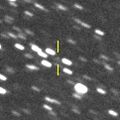
|
Now it is 15.8 mag (June 2, J. Gonzalez). It will brighten rapidly after this. It will be observable at 13.5 mag in good condition in autumn.
Date(TT) R.A. (2000) Decl. Delta r Elong. m1 Best Time(A, h)
June 8 17 40.68 -4 7.7 1.371 2.347 159 15.4 0:38 ( 0, 51)
June 15 17 35.95 -3 42.2 1.324 2.306 160 15.1 0:06 ( 0, 51)
|
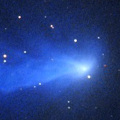
|
Now it is 16.1 mag (June 5, Toshihiko Ikemura, Hirohisa Sato). It will be fading slowly after this. It is observable in good condition in the Northern Hemisphere. In the Southern Hemisphere, it stays extremely low for a while.
Date(TT) R.A. (2000) Decl. Delta r Elong. m1 Best Time(A, h)
June 8 14 51.14 43 26.7 4.301 4.703 107 15.8 21:45 (180, 82)
June 15 14 47.29 42 8.8 4.399 4.755 104 15.9 21:13 (180, 83)
|

|
Now it is 18.7 mag (May 7, Martin Masek). It will brighten rapidly up to 11.5 mag in autumn. In the Northern Hemisphere, it will be observable in excellent condition. In the Southern Hemisphere, it will be extremely low from autumn to winter.
Date(TT) R.A. (2000) Decl. Delta r Elong. m1 Best Time(A, h)
June 8 23 23.93 -17 33.4 1.390 1.748 91 16.3 3:00 (309, 19)
June 15 23 39.46 -15 30.8 1.300 1.707 94 15.9 2:58 (310, 22)
|
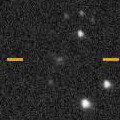
|
Now it is 16.6 mag (May 10, Mount John Observatory, Lake Tekapo). It stays 16 mag for a long time from 2019 to 2020. It is observable in excellent condition in the Southern Hemisphere. It is hardly observable in the Northern Hemisphere.
Date(TT) R.A. (2000) Decl. Delta r Elong. m1 Best Time(A, h)
June 8 11 5.78 -55 29.1 3.359 3.814 109 15.9 20:57 ( 24, -8)
June 15 11 0.11 -54 50.1 3.402 3.787 104 15.9 21:02 ( 28,-11)
|
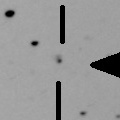
|
Asteroid, but it brightened rapidly. Now it is 16.3 mag (May 24, ATLAS-MLO, Mauna Loa). It is observable in excellent condition in the Southern Hemisphere. It is hardly observable in the Northern Hemisphere.
Date(TT) R.A. (2000) Decl. Delta r Elong. m1 Best Time(A, h)
June 8 22 14.37 -38 54.7 5.985 6.450 113 16.2 3:00 (335, 10)
June 15 22 9.32 -39 30.2 5.878 6.445 119 16.1 2:58 (340, 12)
|

|
It has not been observed yet in this apparition. It is expected to brighten up to 12 mag from August to September. It is observable in good condition in the Northern Hemisphere. It will be low around the high light in the Southern Hemisphere.
Date(TT) R.A. (2000) Decl. Delta r Elong. m1 Best Time(A, h)
June 8 0 46.56 -5 27.8 1.555 1.513 68 16.9 3:00 (286, 12)
June 15 1 4.86 -2 5.0 1.491 1.480 69 16.2 2:58 (284, 16)
|
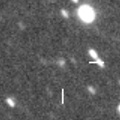
|
Now it is 17.2 mag (May 26, iTelescope Observatory, Siding Spring). It will brighten up to 16.5 mag in June. It is observable in excellent condition in the Southern Hemisphere. It locates low in the Northern Hemisphere.
Date(TT) R.A. (2000) Decl. Delta r Elong. m1 Best Time(A, h)
June 8 16 58.23 -40 31.2 2.745 3.725 162 16.4 23:50 ( 0, 14)
June 15 16 37.29 -41 10.5 2.746 3.711 158 16.4 23:02 ( 0, 14)
|

|
Now it is 16.3 mag (May 23, Ken-ichi Kadota). It will brighten up to 16 mag from June to August, and it will be observable in excellent condition in the Northern Hemisphere. It is not observable in the Southern Hemisphere.
Date(TT) R.A. (2000) Decl. Delta r Elong. m1 Best Time(A, h)
June 8 0 15.64 64 30.7 2.055 1.809 61 16.6 3:00 (212, 43)
June 15 0 9.19 70 32.3 1.958 1.784 64 16.5 2:58 (203, 44)
|

|
It brightened up to 14 mag from autumn to winter in 2018. Now it is fading. Now it is 15.6 mag (May 11, ATLAS-MLO, Mauna Loa). It is observable in excellent condition in the Northern Hemisphere. It locates extremely low in the Southern Hemisphere.
Date(TT) R.A. (2000) Decl. Delta r Elong. m1 Best Time(A, h)
June 8 10 27.88 38 4.8 3.061 2.871 69 16.5 20:57 (110, 47)
June 15 10 35.80 35 51.8 3.180 2.915 65 16.6 21:02 (109, 42)
|

|
It has not been observed yet in this apparition. It will be observable at 16 mag in good condition from summer to autumn. It locates somewhat low in the Southern Hemisphere.
Date(TT) R.A. (2000) Decl. Delta r Elong. m1 Best Time(A, h)
June 8 1 3.21 11 42.6 2.365 2.015 57 16.9 3:00 (269, 19)
June 15 1 17.11 13 21.3 2.306 2.014 60 16.7 2:58 (269, 22)
|

|
Now it is 16.1 mag (June 5, Toshihiko Ikemura, Hirohisa Sato). It will brighten up to 14 mag in winter. It stays observable for a long time in the Southern Hemisphere. It is observable only until early August in the Northern Hemisphere.
Date(TT) R.A. (2000) Decl. Delta r Elong. m1 Best Time(A, h)
June 8 16 39.61 -28 39.8 2.479 3.488 172 16.9 23:32 ( 0, 26)
June 15 16 26.17 -29 51.9 2.440 3.428 164 16.8 22:52 ( 0, 25)
|

|
Now it is 17.3 mag (May 29, Toshihiko Ikemura, Hirohisa Sato). It stays 16-17 mag for a long time until 2020. It is observable in good condition in the Northern Hemisphere. It is not observable at all in the Southern Hemisphere.
Date(TT) R.A. (2000) Decl. Delta r Elong. m1 Best Time(A, h)
June 8 10 55.98 65 54.7 8.783 8.467 68 16.9 20:57 (153, 49)
June 15 10 59.68 65 0.6 8.837 8.470 65 16.9 21:02 (150, 46)
|
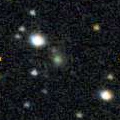
|
Now it is 16.7 mag (May 20, Alexander Baransky). It is expected to be observable at 5-6 mag for a long time from 2022 to 2023. In the Northern Hemisphere, it is not observable at the highlight from 2022 summer to 2023 summer. In the Southern Hemisphere, it stays unobservable for a while. But it will be observable in good condition at the highlight.
Date(TT) R.A. (2000) Decl. Delta r Elong. m1 Best Time(A, h)
June 8 17 47.35 58 43.1 11.334 11.519 97 16.9 0:44 (180, 66)
June 15 17 42.81 58 42.7 11.288 11.473 97 16.9 0:12 (180, 66)
|

|
Now it is 16.4 mag (May 26, Toshihiko Ikemura, Hirohisa Sato). It is observable at 17 mag in good condition in 2019. It locates somewhat low in the Northern Hemisphere.
Date(TT) R.A. (2000) Decl. Delta r Elong. m1 Best Time(A, h)
June 8 15 20.25 -15 25.1 2.959 3.902 154 17.0 22:14 ( 0, 40)
June 15 15 16.84 -15 23.0 3.016 3.910 147 17.1 21:43 ( 0, 40)
|

|
Now it is 17.7 mag (May 16, M. Masek). It will brighten up to 17 mag from June to July, and will be observable in good condition.
Date(TT) R.A. (2000) Decl. Delta r Elong. m1 Best Time(A, h)
June 8 19 3.70 -27 27.5 1.506 2.450 152 17.3 2:02 ( 0, 27)
June 15 18 31.60 -25 2.2 1.433 2.431 166 17.1 1:03 ( 0, 30)
|
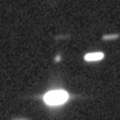
|
Now it is 17.5 mag (May 26, Toshihiko Ikemura, Hirohisa Sato). It is expected to brighten up to 13.5 mag in 2021, and it will be observable in good condition in the Southern Hemisphere. In the Northern Hemisphere, it is not observable at the highlight.
Date(TT) R.A. (2000) Decl. Delta r Elong. m1 Best Time(A, h)
June 8 13 40.47 7 20.0 6.598 7.190 122 17.7 20:57 ( 12, 62)
June 15 13 38.44 6 57.3 6.647 7.145 115 17.7 21:02 ( 28, 59)
|
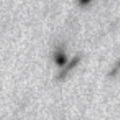
|
Now it is 17.3 mag (May 26, iTelescope Observatory, Siding Spring). In the Southern Hemisphere, it is observable at 17.5 mag in good condition from spring to summer. In the Northern Hemisphere, it is not observable at all.
Date(TT) R.A. (2000) Decl. Delta r Elong. m1 Best Time(A, h)
June 8 16 40.77 -57 1.9 3.516 4.391 145 17.7 23:35 ( 0, -2)
June 15 16 34.21 -56 39.5 3.520 4.391 145 17.7 23:01 ( 0, -2)
|

|
It has not been observed yet in this apparition. Now it is fainter than 21.5 mag (Mar. 10, Erwin Schwab). It will be observable at 17.5 mag from June to August.
Date(TT) R.A. (2000) Decl. Delta r Elong. m1 Best Time(A, h)
June 8 18 57.74 -9 26.1 1.222 2.158 149 17.8 1:55 ( 0, 46)
June 15 18 55.48 -9 58.9 1.178 2.145 155 17.7 1:25 ( 0, 45)
|

|
Now it is 17.7 mag (May 14, Catalina Sky Survey). It will be observable at 17.5 mag in excellent condition in the Northern Hemisphere. It locates somewhat low in the Southern Hemisphere. It is faint as 19.0 mag recently (May 29, Toshihiko Ikemura, Hirohisa Sato).
Date(TT) R.A. (2000) Decl. Delta r Elong. m1 Best Time(A, h)
June 8 19 55.55 29 4.3 1.420 2.047 113 17.9 2:54 ( 0, 84)
June 15 19 14.54 30 28.1 1.338 2.053 120 17.8 1:46 ( 0, 85)
|
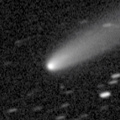
|
It brightened up to 13.2 mag from December to March (Dec. 30, Chris Wyatt). Now it is fading. It has already faded down to 17.5 mag (June 5, Toshihiko Ikemura, Hirohisa Sato). It will be fainter than 18 mag in June.
Date(TT) R.A. (2000) Decl. Delta r Elong. m1 Best Time(A, h)
June 8 11 55.24 -3 49.2 1.851 2.312 103 17.8 20:57 ( 44, 41)
June 15 12 3.02 -4 23.7 1.968 2.353 99 18.1 21:02 ( 50, 37)
|

|
Now it is 17.4 mag (May 7, Toshihiko Ikemura, Hirohisa Sato). It will brighten up to 17.5 mag from June to July.
Date(TT) R.A. (2000) Decl. Delta r Elong. m1 Best Time(A, h)
June 8 20 23.32 -24 39.1 1.750 2.562 134 17.8 3:00 (355, 30)
June 15 20 24.86 -26 11.1 1.716 2.582 140 17.8 2:55 ( 0, 29)
|

|
It has not been observed yet in this apparition. It will brighten up to 15.5 mag and it will be observable in good condition in autumn.
Date(TT) R.A. (2000) Decl. Delta r Elong. m1 Best Time(A, h)
June 8 23 25.75 -6 51.3 2.846 2.975 87 18.0 3:00 (301, 27)
June 15 23 32.69 -6 21.0 2.723 2.942 92 17.8 2:58 (304, 30)
|
|
![]()
 C/2018 F4 ( PanSTARRS )
C/2018 F4 ( PanSTARRS ) A/2017 U7
A/2017 U7 168P/Hergenrother
168P/Hergenrother C/2018 KJ3 ( Lemmon )
C/2018 KJ3 ( Lemmon ) C/2019 J2 ( Palomar )
C/2019 J2 ( Palomar ) (944) Hidalgo
(944) Hidalgo 261P/Larson
261P/Larson C/2019 K1 ( ATLAS )
C/2019 K1 ( ATLAS ) C/2010 U3 ( Boattini )
C/2010 U3 ( Boattini ) C/2017 K2 ( PanSTARRS )
C/2017 K2 ( PanSTARRS ) 74P/Smirnova-Chernykh
74P/Smirnova-Chernykh C/2019 J3 ( ATLAS )
C/2019 J3 ( ATLAS ) C/2019 F1 ( ATLAS-Africano )
C/2019 F1 ( ATLAS-Africano ) 186P/Garradd
186P/Garradd P/2012 K3 ( Gibbs )
P/2012 K3 ( Gibbs ) C/2019 JU6 ( ATLAS )
C/2019 JU6 ( ATLAS ) 60P/Tsuchinshan 2
60P/Tsuchinshan 2 C/2019 J1 ( Lemmon )
C/2019 J1 ( Lemmon ) 101P/Chernykh
101P/Chernykh![]()

























